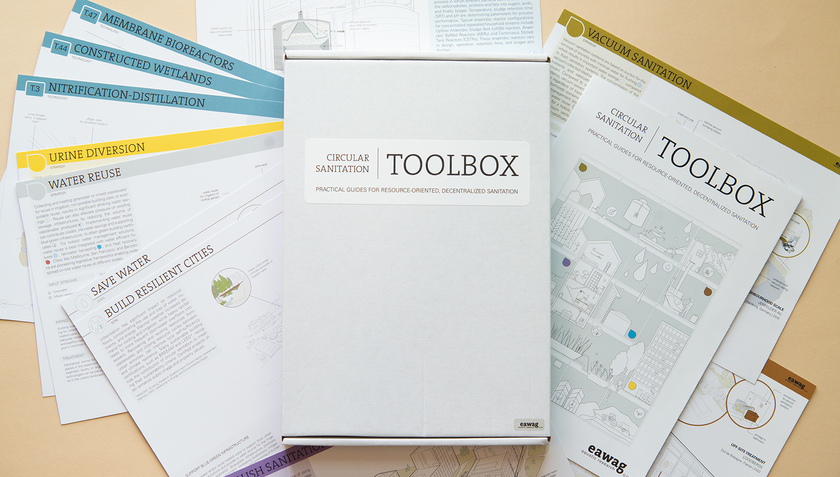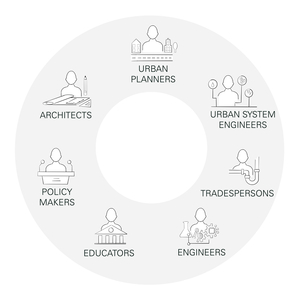Department Process Engineering

BACKGROUND & SCOPE
The Circular Sanitation TOOLBOX was developed in response to requests from practitioners looking for know-how on resource-oriented and/or decentralized sanitation. In this emerging field, information is often scattered and technical—making it difficult to navigate, especially for newcomers. There is a growing demand for simplified information tailored to a wider range of stakeholders beyond environmental engineers—those involved in the planning, construction, and management of sanitation systems.
To meet this need, the toolbox provides information that is brief, structured, and visually engaging. Content is organized into three types of guides: Goals, Strategies, and Technologies. Each guide works as a standalone resource, but they can also be used together to build a narrative that answers to:
- What goal do I want to achieve?
- Which strategy will help me achieve it?
- Which technologies should I implement?
The guides also present case studies that show real-world implementation across urban, peri-urban, and rural settings—ranging from single households to neighborhood-scale systems. All featured technologies have been implemented in practice.
The TOOLBOX’s success lies in the documents’ brevity, structure, and visual appeal as a navigational portfolio of circular sanitation.


TOOLBOX AUDIENCE
This toolbox is designed for architects and planners responsible for integrating circular sanitation into projects and developments. It offers an initial overview of available options and serves as a communicative planning tool for engaging project stakeholders. Policy makers, educators, engineers, and tradespersons will also find it useful for accessing simplified, practical information. The toolbox is developed to guide the imagination and discussions of what makes sense, how things fit together, what can be implemented, and what questions to ask technical experts.
WHAT'S IN THE TOOLBOX?
BOOKLET
The booklet introduces Circular Sanitation as defined in the TOOLBOX. It positions the broader portfolio of circular sanitation solutions within the context of urban water management, which is facing increasing global challenges including resource scarcity, water pollution, climate change, urbanization, and aging infrastructure. The TOOLBOX illustrates that these is opportunity to consider the coexistence of solutions of different scales and configurations to adress such challenges and respond to local demands.
BOOKLET
This introductory booklet provides an overview of the Circular Sanitation Toolbox and its parts.
GUIDES
Guides present summarized information per goal, strategy and technology. The chosen categorization aims for detail and clarity, while avoiding repetition of information. Each guide functions as a stand-alone document, though used together they can help practitioners build a story: from identifying their GOALS, to exploring different implementation STRATEGIES, to selecting appropriate TECHNOLOGIES.
In the dropdowns below, click on the icon or title to download each individual guide. Or download all guides on the right side of this website.
GOALS
The goals below reflect common drivers behind sanitation planning and serve as a starting point for identifying context-appropriate strategies and technologies.
Freshwater resources are under growing pressure from climate change (e.g., heat waves, droughts) and rapid urbanization, leading to increased water scarcity in many parts of the world. Decreased and variable supply, paired with higher demand and greater water use contribute to this issue. Reducing demand, reusing water, and utilizing renewable sources like rainwater can enhance local water availability.
Current linear nutrient flows involve: 1) resource-intensive fertilizer production dependent on fossil fuels and finite ore reserves, 2) farming systems that deplete soil nutrients and organic matter, and 3) waste management practices that lead to nutrient loss to air, water, and landfills, and pollution, like the eutrophication of surface waters. Recovering nutrients and organic matter from human excreta can reduce losses and produce renewable fertilizers.
Heating of domestic water often relies on fossil fuels. Residual heat from showers, sinks, and appliances quickly dissipates into the receiving sewer system and wastewater treatment plant. Energy savings can be achieved by reducing hot water usage or recovering heat from wastewater. Additionally, organic matter can be valorized to produce biogas.
Urbanization impacts resource flows, concentrating water, nutrient, and energy use and loss. Warmer weather increases cooling and irrigation demand, while heavy rainfall causes more stormwater overflows into sewers. Recovering resources from wastewater and linking urban functions (e.g., domestic wastewater and urban landscaping) can boost self-sufficiency and climate resilience. Sustainable building certifications like BREEAM and LEED recognize sanitation contributions to meet their criteria. Certified projects often enhance public image and property values.
In some areas, centralized infrastructure is absent, such as in remote locations or where urbanization outpaces development. In other contexts, existing systems may be at capacity. Decentralized treatment can extend infrastructure capacity to defer costly investments, and provide flexible, autonomous solutions for design and operation. Decentralized treatment can be an alternative or compliment centralized infrastructure.
STRATEGIES
Circular sanitation involves strategies for collection, conveyance, treatment, and resource recovery. Many strategies can be combined, while others are mutually exclusive (e.g., dry sanitation and vaccum sanitation). Most strategies can be implemented alongside existing centralized infrastructure. When selecting strategies, it is important to consider goals and context.
Urine diversion is the separation of urine from the rest of the remaining wastewater streams. This strategy helps divert nutrient loads from existing treatment plants and can yield nutrient-rich fertilizers.
Dry sanitation refers to the collection of excreta or feces without flush water, contributing to water savings. Treatment of the excreta or feces yields soil amendments.
Vacuum sanitation is the collection of excreta via vacuum piping under negative pressure, with minimal water for flushing. In addition to saving water, liquid and soild fetilizers, as well as soil amendments can be recovered. The organics can be valorized to produce biogas.
Flush sanitation refers to the standard practice of using flush toilets to handle human excreta. Treatment allows for the recovery of water from the liquid fraction, and nutrients and organics from the solid fraction.
Water reuse includes the collection and treatment of greywater, or mixed wastewater, for non-potable or potable reuse of the treated water. Water reuse results in drinking water savings.
Water-efficient fixtures include applicances and fitting that reduce water demand. It fixtures reduce hot water demand, energy demand for heating is also reduced.
Rainwater harvesting refers to the collection of rainwater from above-ground surfaces (e.g.,rooftops) during rainfall events. Rainwater can be used for non-potable and potable applications, replacing drinking water demand.
Heat recovery refers to the use of heat exchangers or heat pumps to recover heat from greywater or mixed wastewater to save energy.
TECHNOLOGIES
Resource treatment and recovery can be achieved using single or combined technologies, depending on the input stream, desired output, and context-specific factors (e.g., space, cost, location).
Extended storage of urine is the simplest, cheapest and most common method to hygienize urine. Urine storage achieves partial pathogen inactivation due to the combination of increased pH, temperature and time. Recommended storage time is at least six months. To enhance pathogen inactivation and reduce treatment time, the temperature of stored urine can be raised. This process is called pasteurization.
Nitrification-Distillation of urine (know as the VUNA process) treats urine to produce a concentrated liquid fertilizer. It combines biological treatment to stabilize nutrients, activated carbon filtration to remove micropollutants, and vacuum distillation to concentrate and hygienize the output. This high-tech solution is best for urine volumes of 500L/day or more.
Struvite precipitation is a nutrient recovery technology that uses a chemical reaction to form magnesium ammonium phosphate hexahydrate (MgNH4PO4 •6H2O), or MAP. High recovery of phosphorus (90%) can be achieved in many applications. Struvite is a bioavailable, slow release fertilizer that can be stored, transported and easily applied to fields.
Composting is the microbial degradation of organic matter under aerobic conditions to a humus-like product: compost. On-site composting, often in chambers or containers, achieves mesophilic conditions (20-45 °C), but not thermophilic conditions (45-70 °C). Vermicomposting, relies on both earthworms and microorganisms for the degradation of organic matter. The resulting compost can be used as a soil amendment if properly stabilized and sanitized.
Composting is the microbiologial degradation of organic matter to a humus-like stable product. Off-site composting, where waste is collected and transported to a dedicated facility, is often larger and more controlled compared to on-site setups. Off-site composting often occurs in aerated static piles, windrows (tuned regularly), or in-vessel systems (containers with precise control).
Anaerobic digestion is the degradation of organic matter by microorganisms in the absence of oxygen. The technology is well-suited for wastewater and wastes with high levels of organic matter The technology yields biogas, a mix of 50-75 % methane (CH4) and 25-50 % carbon dioxide (CO2), a reduced and stabilised sludge volume, and an effluent.
Settling tanks and screens are used for the separation of large solids and suspended matter from wastewater streams. These technologies are generally implemented as a primary treatment step to protect and/or to simplify subsequent biological or advanced treatment steps in water treatment and reuse.
Vermifilters treat blackwater or mixed wastewater in a multi-layered system that includes solid-liquid separation, vermicomposting of the solid fraction, and aerobic biological treatment of the liquid fraction. The solids are broken down by earthworms and microbes into compost, while the liquid passes through porous layers for further biological treatment.
Constructed wetlands are engineered systems that mimic natural wetlands to improve water quality. Water flows through or over a substrate planted with reeds and plants, where microbes and plants work together to remove nutrients and contaminants. Wetlands are low-tech, nature-based solutions that in addition to treating water, offer ecosystem services, and have recreational and aesthetic value.
Trickling filters are aerobic biological reactors where wastewater flows over a fixed bed of media (e.g., plastic, gravel, lava rock), allowing biofilms growing on the media to degrade organic matter. They operate passively or with energy input for recirculation, and require good airflow and drainage to maintain aerobic conditions.
Aerated bioreactors make use of microorganisms growing in flocs (i.e., activated sludge), and/or biofilms on fixed beds or moving carriers, to degrade organics and remove nutrients from wastewater. Active bubble aeration maintains aerobic conditions and keeps the activated sludge and/or carriers suspended. Variations include SBR, MBBR, SFBBR, IFAS, and membrane bioreactors (MBR).
Membrane bioreactors combine biological treatment with membrane filtration to produce high-quality treated water. Microorganisms in the aerated bioreactor degrade organics and nutrients, while micro- or ultrafiltration membranes remove solids and pathogens. MBRs are compact and well-suited for contexts where space is limited.
Membrane filtration is a pressure-driven separation process where water is pumped through a semi-permeable membrane to filter out contaminants. Membrane pores allow water to filter through, but hold back contaminants that do not fit through the pores. Membrane units are often used as a filtration step after biological treatment of greywater or mixed wastewater, or for the treatment of rainwater.
Granular media filtration removes suspended and colloidal particles by passing water through layers of granular materials like sand, activated carbon, or gravel. Particles are retained by surface straining, adsorption, ion exchange, or settling. Filters can be pressure-based (closed system) or open sand filters using gravity.
Ultraviolet (UV) disinfection and chlorination are treatments to inactivate pathogens, including bacteria, viruses and protozoa present in the water. UV disinfection uses light to damage pathogens’ DNA, preventing reproduction; chlorination adds chlorine to water to kill pathogens chemically. Chlorination is the only treatment that provides residual disinfection, preventing regrowth of pathogens in water distribution networks and storage tanks.
Ozonation and other AOPs can be used for the targeted removal of organic micropollutants (like pesticides, pharmaceuticals and PFAS) from treated water for potable reuse applications, or when stricter discharge regulations apply.
SUPPORTING DOCUMENTS
CASE STUDIES
All of the case studies included in the toolbox have been organized into a speadsheet to provide a quick overview of and allow for comparison between case studies. The database also includes project partners (engineers, planners, technology providers and other stakeholders) involved in each case study (where available).

This work is distributed under the Creative Commons Attribution 4.0 License. They may be freely reproduced, distributed and modified, provided the source is acknowledged. Information about the licence can be found at: https://creativecommons.org/licenses/by/4.0
The TOOLBOX documents available online are the most up to date versions.
Download the Toolbox
You can download the TOOLBOX here as combined files, either by category or the entire toolbox. To download individual goal, strategy or technology guides, see the respective guides headings in the main text of this website.
- Booklet
- Goals
- Strategies
- Technologies
- All Guides (Goals, Strategies, Technologies)
- Complete TOOLBOX (Booklet, Goals, Strategies, & Technologies)
Additional resources
Sanitation Compendium (Eawag)
A comprehensive reference of sanitation systems and technologies for planning and decision-making.
www.sandec.ch/compendium
Guide to Sanitation Resource-Recovery Products & Technologies
A practical supplement to the Eawag Compendium, focused on reuse.
https://publications.slu.se
SaniChoice
Sanitation technology decision support tool for planning or for capacity development.
https://www.sanichoice.net
https://www.sanichoice.net/app/technologies
Sustainable Sanitation and Water Management Toolbox
An online platform offering tools, case studies, and guidance for implementing sustainable water and sanitation solutions.
https://sswm.info
EgestaBase
A global database compiling information on resource recovery from human excreta, with data on composition, flows, and reuse potential.
https://www.egestabase.net
SEI Resource Recovery Toolbox
A collection of tools, case studies, and guidelines to support safe and productive reuse of sanitation products.
https://www.resource-recovery.info/en/toolbox
Valoo Platform
A Swiss platform promoting circular sanitation solutions and linking stakeholders in the resource-recovery sector.
https://va-loo.ch
Valoo Case Studies
Circular Sanitation in Practice: A showcase of innovative, decentralized systems applied in various contexts in Switzerland.
https://va-loo.ch/articles/circular-sanitation-in-practice/
EPA Factsheets (U.S. Environmental Protection Agency)
U.S. Environmental Protection Agency resources summarizing key wastewater, biosolids, and resource recovery topics.
https://www.epa.gov
NEWR - Non-potable Environmental and Economic Water Reuse Calculator
Tool to identify environmentally and cost effective options for onsite non-potable reuse based on geography, building specifications, source water type, and end use.
https://www.epa.gov/sites/default/files/widgets/newr-calculator/index.html
Water in Circular Economy and Resilience (WICER) Case Studies
Real-world examples from the World Bank showcasing circular and resilient water management solutions.
https://www.worldbank.org/en/programs/wicer/case-studies
Saniwijzer (in Dutch)
A Dutch knowledge portal providing information, tools, and examples for sustainable sanitation systems.
http://www.saniwijzer.nl
Source Separation and Decentralization for Wastewater Management (Book)
By Tove A. Larsen (Editor), Kai M. Udert (Editor), Judit Lienert (Editor). A comprehensive view of the state of the art of source separation and decentralization.
https://library.oapen.org/handle/20.500.12657/24364
Publishing details
Wielemaker, R., Conthe, M., Congiu, G., and Morgenroth, E., 2025. Circular Sanitation Toolbox. First Edition. Eawag, Swiss Federal Institute of Aquatic Science and Technology, 8600 Dübendorf, Switzerland.
https://doi.org/10.55408/eawag:34671
Graphic Design & Illustrations: Rosanne Wielemaker and Monica Conthe
Cover: Rosanne Wielemaker
© Eawag, 2025
Eawag
Überlandstrasse 133
P.O. Box 611
8600 Dübendorf
Switzerland
+41 (0)44 823 52 86
www.eawag.ch
www.eawag.ch/waterhub
The Circular Sanitation Toolbox includes a compilation of case studies that have implemented strategies and technologies for resource-oriented, decentralized sanitation across the world. The technologies and systems were designed, developed, and implemented by engineers, planners and/or technology providers involved in each case study. The inclusion of these case studies does not imply endorsement or authorship of the technical solutions described.
Circular Sanitation TOOLBOX- printed copies
Thank you for your interest in purchasing the Circular Sanitation Toolbox. The printed toolbox will include the booklet and the guides, printed in color on high quality paper (350g). Each toolbox is presented in a box. The printed version is a great visual tool that lends itself for use in meetings, workshops, and classrooms. It also makes for a great (business) gift!
PRICE: 30 CHF, price for larger orders (>5 copies) upon request. Prices include VAT & Shipping.
Please fill out your details below and indicate the number of copies you would like to order.
We will send you an invoice for the payment, and thereafter the ordered copies.
Thank you!


